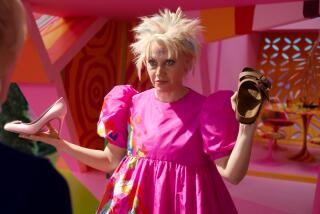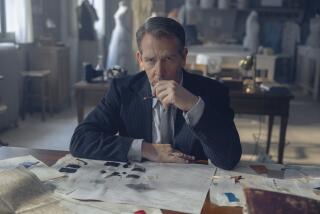How daunting is taking on the costume design for a film called ‘The Dressmaker’? Very
“The Dressmaker” is a 1950s black comedy of revenge directed by Jocelyn Moorhouse. It stars Kate Winslet as Myrtle “Tilly” Dunnage, a glamorous dressmaker who returns from the big city to her dusty rural nowhere Australian town after nearly two decades. Poised with her sewing machine and a newly acquired haute couture Parisian style, she transforms Dungatar’s women into fashionistas and exacts revenge on those who wronged her in her youth along the way.
Aussie designers Margot Wilson and Marion Boyce created Winslet’s costumes and the hundreds of other secondary clothes, respectively. Even splitting the workload, each says they had full plates and were glad they could each focus on their chosen task. “With the title we knew it was going to be a clothes-showcasing film,” says Wilson, “and with the complicated tale wrapped around [the costumes], we had to nail it. I’m glad we could creatively focus like we did.”
First up, Wilson talks about dressing Winslet, whose character blows into town like an elegantly vengeful whirlwind.
You were hired to work on Tilly’s costumes exclusively. Did that develop after you started or was it clear from the outset?
It’s how we started. [The producers] decided since Tilly studied fashion design in France she needed to look quite different from the rest of the [small Aussie town’s] world, and thought it a good idea to bring someone on to concentrate on Tilly exclusively. She’d studied and learned to sew in Europe and had big design influences and, well, the title says it all: “The Dressmaker.” She had to fit the part. We had to get it right.
See the most read stories this hour »
Winslet’s costumes are quite va-va-voom and body-hugging. Is this taken from the book the film is based on or is it how you imagined her?
It’s my envisioning. After reading the script I wanted to keep Kate’s costumes quite simple; we didn’t want anything too fussy. Also, you have to look at the neutral landscape canvas of the Australian outback and make it all work on screen. You have a lot of influences coming in and you have to make it work as a whole.
And it’s almost as if Tilly’s costumes tell the narrative and they seem to move the action forward?
Yes. So again, we kept it quite tailored and with simple lines. No patterns or florals, it’s a more duo-block, royal color scheme, a clean look. And I’d worked with Kate prior on “Triple 9,” so I knew what worked and what didn’t. And Kate herself is very savvy with what works on her, too.
How did the glam red gown she wore to the rugby game come about?
I’d been carrying around this roll of red moiré silk taffeta for 20 years that I’d bought in Milan and I was so thrilled I was able to use it for that red dress. It was the perfect place. It was so rich and luxurious that fabric, and you could really emphasize the fabric’s beauty. Between it and the black dress [also worn at the game], she was exercising her ability and showcasing what a dress can do for a woman. Which is a big theme of the film.
How did the ensemble dressing play into the film’s narrative?
It’s fun for designers because it’s of a bygone era and it really does show how powerful ensemble dressing can be. For instance, Tilly comes into town – as well as into the film – with a purpose and a force, and she leaves in a similar fashion. She’s come back to right the wrongs of the past and when she exits the film, it had to be as striking as how she entered it. So, she wears gloves when she arrives in the film and when she’s going out, the only times in the film. It’s something subtle but effective. And showcases the power ensemble dressing can create.
[Below, Boyce speaks to the look of the townspeople, who are no match for Tilly’s skills in design and cunning.]
The first key transformation, of Gertrude, the shopkeeper’s daughter, had that “Pygmalion” thing going on. How did her lovely ethereal silver peppermint ball gown come about?
The town and its background has a very low color palette and I really wanted her to have a princess moment, I wanted her to sparkle. The temptation is to put her in a vibrant color. Yet since it was the first time we’d see her in something attractive and since it was going to be a journey, if you pop out in the first scene with a bright color you really have nowhere to go.
The townswomen strolling the main street in full-blown fashionista garb was a wonderful scene. How did you approach designing it?
I started off with Gertrude as she was head peacock. I was struggling with the whole outback thing; the entire place was so dusty and petrified, and then I begin to see these birds swooping down through the currents and their big wing spans and that’s where Gertrude’s accordion cape came from; the ladies are all birds preening.
The secretly cross-dressing police officer, Sgt. Farrat (Hugo Weaving) and his love of cloth and fabric was fabulous. Was his matador costume vintage?
The jacket was vintage but the pants we made as matadors have interesting bodies; they’re big and muscular on top but slim and small like horse jockeys on the bottom. There was also a scene where he touched the cloth, lovingly. It really moved me because I often pick up a piece of cloth and to me it does have that emotion. Textile can have a lot of emotion to it, like music.
ALSO:
Oscars 2016 preview: Waiting for the day when inclusion is no longer news
True stories are grabbing the Oscar spotlight from novels like never before
More to Read
From the Oscars to the Emmys.
Get the Envelope newsletter for exclusive awards season coverage, behind-the-scenes stories from the Envelope podcast and columnist Glenn Whipp’s must-read analysis.
You may occasionally receive promotional content from the Los Angeles Times.






